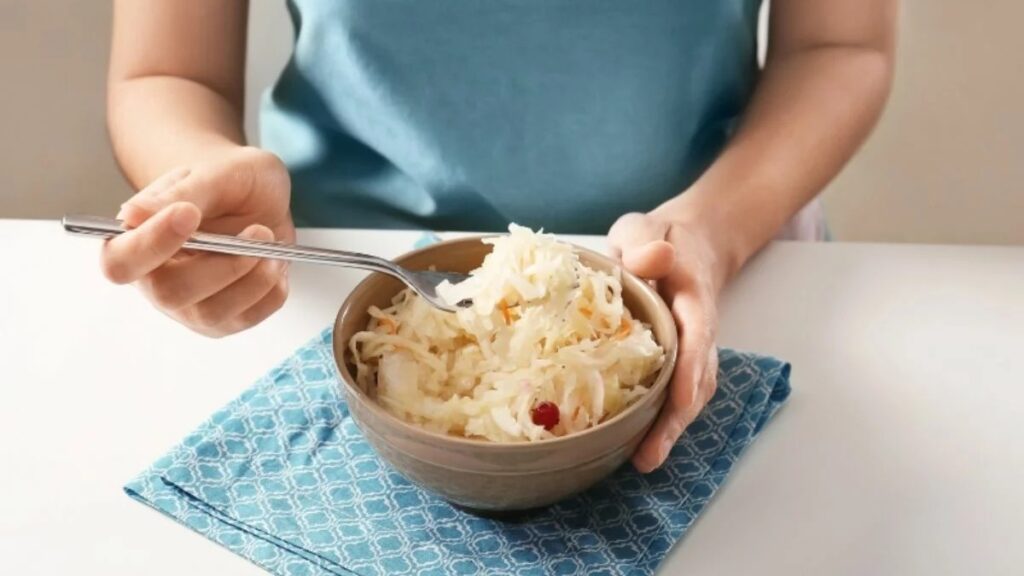Salt is a very valuable ally in making fermented vegetables (lacto-fermentation). But its use still raises many questions!
This article will help you understand the role of salt in fermentation, how to choose the right salt, and how much salt to add, whether dry salting or brining.
To simply know how much salt to add to your lacto-fermentations (read this short version)
Jump directly to the section that interests you:
- What is salt used for?
- Which salt to use?
- How to choose between brine and dry salting?
- How to do a dry salting?
- How to make a brine?
- How much salt to add?
- Can we do a fermentation without salt?
Why Do I Need Salt To Ferment Vegetables?
Salt has many functions in lacto-fermentation. First of all, salt neutralizes pathogenic microorganisms. In doing so, it allows good bacteria to establish themselves before bad ones do. No wonder salt has been used to preserve food since the dawn of time!
Secondly, salt helps to draw water out of the vegetables. This creates a natural brine, full of nutrients for the microorganisms. It also covers the vegetables and prevents exposure to oxygen, creating the perfect environment for lacto-fermentation.
Thirdly, salt slows down the softening of vegetables. The more salt you add, the slower the fermentation, and the longer the vegetables will remain crisp.
Finally, salt is what makes fermented food taste good! A pickle, sauerkraut, kimchi… We like them with a little pinch of salt!
Which Salt to Use for Fermenting Vegetables?
It’s simple, salt must be “natural”, i.e. without additives.
Salt enriched with iodine or anti-caking agents (like many table salts) should be avoided. They could interfere with fermentation, and affect the taste, colour, or texture of the vegetables.
You can therefore use pickling salt, sea salt, or even pink Himalayan salt. It doesn’t matter! The only ingredient should be “salt”.
Want to learn more? Read Which salt to use for lacto-fermentation?
How to Choose Between Brining and Dry Salting?
There are two techniques for adding salt during lacto-fermentation: either salt is added directly to the vegetables (dry salting) or a solution of water and salt is used (brine).
To choose between the two techniques, we need to determine whether the vegetables can produce enough water themselves to be submerged.
Remember, we always try to limit the contact of the vegetables with oxygen!
- Dry salting is used if the vegetables are finely cut, crushed, or have high water content. This will allow them to soak sufficiently so that they are covered with liquid when put in the container.
- Brine is used if the vegetables are whole, chunky, or have little water. They will not be able to produce enough liquid to be covered.
Use dry salting with recipes such as sauerkraut, kimchi, shredded carrots, and salsa.
Use brine to make pickles, carrot sticks, and fermented hot sauces.
If in doubt, it is always best to dry salt (without brine), as the water will dilute flavours. For example, sauerkraut with added water will be a little less tasty than sauerkraut without added water.
How to Dry Salt Vegetables?
Dry salting is used when the vegetables are sufficiently soaked to be covered with their own liquid (if they are finely cut, crushed, or have a high water content).
For this technique, salt is added directly to the finely cut vegetables. The vegetables are then left to soak for 10 to 15 minutes.
The liquid will come out of the vegetables, resulting in natural brine. It will submerge the vegetables and thus limit their contact with the air.
See also How Much Salt to Add for Dry Salting?
How to Make a Brine for Lacto-Fermentation?
Brine is used when the vegetables cannot produce enough liquid to be covered with it. A solution of water and salt (brine) is therefore added to submerge them and limit their contact with the air.
To make a brine:
- Place the vegetables in a jar
- Calculate the proportion of salt according to the volume of the jar
- Add the salt
- Completely cover the vegetables with water (no need to stir, the salt will dissolve)
Why do we calculate from the volume of the jar? Because the volume of a jar in millilitres is equivalent to the weight of the ingredients and water in grams. So we make sure we have added enough salt, based on the total weight of the ingredients, not just the water.
It is not recommended to create a separate brine that is then added to the vegetables. Indeed, with this technique, you may not have added enough salt. Remember that vegetables absorb some of the salt! Also, if there is little room for brine in the container, the vegetables will be less salty than expected.
See also How Much Salt to Add to Make a Brine?
How Much Salt to Add to My Fermentation?
Percentage (%) is the universal method of calculating salt. It is the simplest way to get the right proportion, regardless of the weight or volume of the ingredients.
It is important to do the calculations using the metric system (grams or millilitres), as the calculation of percentages is not practical with the imperial system.
For example, for a recipe with 2% salt, if you have 1kg of cabbage, you will need to add 20 grams of salt (2% of 1000g), or 4 tsp.
1000g x 0.02 (2%) = 20g
The following table gives an idea of the percentage of salt to use, depending on the vegetable you want to ferment:
Not sure? Generally, we recommend using 2% of the weight or volume of the ingredients in salt in your lacto-fermentations.
(See How to Choose Between Brining and Dry Salting to find out whether you should calculate from weight or volume).
To remember:
- The less salt (1 to 2% salt), the faster the fermentation.
- The more salt (3 to 10% salt), the crisper, mould resistant, and long-lasting the vegetables are.
Please note that when the salt concentration is below 2%, wild fermentation is no longer an option.
It is then necessary to add a vegetable starter culture and/or calcium chloride to prevent contamination of the fermentation process by pathogenic agents.
It is not recommended to add less than 1% salt (even with a starter culture) because fermentation could fail.
How Much Salt to Add for Dry Salting?
When you want to add salt directly without adding water, you calculate the percentage of salt to use according to the total weight of the ingredients.
It is generally recommended to add 2% of the weight of the ingredients, but this can vary (see How Much Salt to Add to My Fermentation?).
To ferment 1kg of cabbage at 2% salt, you would need to add 20g of salt (1 tbsp.).
1000g x 0.02 (aka 2%) = 20g
Here is a table to help you calculate the salt to add according to the weight of your vegetables, and the different percentages of salt you could add:
How Much Salt to Add to Make a Brine?
When you want to make a brine (salt + water) to cover the vegetables, you calculate the percentage of salt to use according to the volume of the jar.
Indeed, volume (in the metric system) is equivalent to weight.
Calculating the salt according to the volume gives a good idea of the total weight of the ingredients and water. This prevents you from ending up with too little salt!
It is generally recommended to add 2% of the volume of the ingredients, but this can vary (see How Much Salt to Add to My Fermentation?).
To ferment vegetables at 2% salt in a 1L jar, you would need to add 20g of salt (1 tbsp.).
1000ml x 0.02 (aka 2%) = 20g
Here is a table to help you calculate the salt to add according to the volume of your container, and the different percentages of salt you could add:
If you make a separate brine without the vegetables (not a recommended technique), it is necessary to use a higher percentage of salt. When the brine is added to the vegetables, the salt will blend with them and the final salt content will be reduced.
How Many Grams of Salt per Cooking Utensil?
It is important to weigh the ingredients, but you don’t need a scale to weigh the salt. A simple spoon is enough to get the right amount of salt to add.
There are small differences in weight between fine salt and coarse salt, but these differences do not significantly affect the quality of the results!
If you are wondering how much a teaspoon or tablespoon of salt weighs, here is the answer!
Is It Possible to Make Lacto-Fermentation Without Salt?
It is possible, but the risk of failure is greater.
Salt prevents pathogenic microorganisms from settling in. Without salt, the lactic acid bacteria (which we want to favour) have a harder time competing. As a result, you may end up with mould for example.
To give a boost, you can add an extra source of lactic acid bacteria at the beginning of the fermentation: some liquid from a previous fermentation, whey, or Caldwell-type lactic acid bacteria.
Salt-free lacto-fermentations are often very short (a few days), as the vegetables quickly soften.
Therefore, if you want to reduce the salt in your fermentations, we advise you not to go below 1% salt to reduce the risk of failure and to have satisfactory results.

